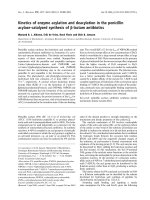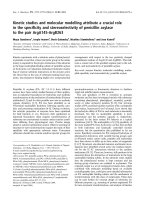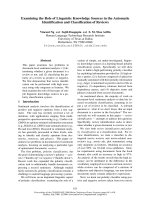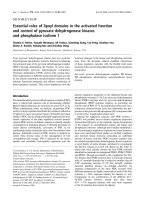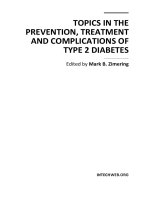TOPICS IN THE PREVENTION, TREATMENT AND COMPLICATIONS OF TYPE 2 DIABETES pptx
Bạn đang xem bản rút gọn của tài liệu. Xem và tải ngay bản đầy đủ của tài liệu tại đây (9.1 MB, 352 trang )
TOPICS IN THE
PREVENTION, TREATMENT
AND COMPLICATIONS OF
TYPE 2 DIABETES
Edited by Mark B. Zimering
Topics in the Prevention, Treatment and Complications of Type 2 Diabetes
Edited by Mark B. Zimering
Published by InTech
Janeza Trdine 9, 51000 Rijeka, Croatia
Copyright © 2011 InTech
All chapters are Open Access distributed under the Creative Commons Attribution 3.0
license, which permits to copy, distribute, transmit, and adapt the work in any medium,
so long as the original work is properly cited. After this work has been published by
InTech, authors have the right to republish it, in whole or part, in any publication of
which they are the author, and to make other personal use of the work. Any republication,
referencing or personal use of the work must explicitly identify the original source.
As for readers, this license allows users to download, copy and build upon published
chapters even for commercial purposes, as long as the author and publisher are properly
credited, which ensures maximum dissemination and a wider impact of our publications.
Notice
Statements and opinions expressed in the chapters are these of the individual contributors
and not necessarily those of the editors or publisher. No responsibility is accepted for the
accuracy of information contained in the published chapters. The publisher assumes no
responsibility for any damage or injury to persons or property arising out of the use of any
materials, instructions, methods or ideas contained in the book.
Publishing Process Manager Mirna Cvijic
Technical Editor Teodora Smiljanic
Cover Designer Jan Hyrat
Image Copyright ruzanna, 2011. Used under license from Shutterstock.com
First published October, 2011
Printed in Croatia
A free online edition of this book is available at www.intechopen.com
Additional hard copies can be obtained from
Topics in the Prevention, Treatment and Complications of Type 2 Diabetes,
Edited Mark B. Zimering
p. cm.
ISBN 978-953-307-590-7
free online editions of InTech
Books and Journals can be found at
www.intechopen.com
Contents
Preface IX
Part 1
Economic Burden & Relation to Alzheimer's Disease 1
Chapter 1
Burden of Diabetes Type 2
Through Modelling and Simulation 3
Maja Atanasijević-Kunc and Jože Drinovec
Chapter 2
Alzheimer’s Disease and Type 2 Diabetes:
Different Pathologies and Same Features 29
Marta Di Carlo, Pasquale Picone, Rita Carrotta,
Daniela Giacomazza and P.L. San Biagio
Chapter 3
Insulin Resistance and Alzheimer’s Disease 53
Sung Min Son, Hong Joon Shin and Inhee Mook-Jung
Part 2
Novel Treatments
75
Chapter 4
Incretin-Based Treatment Strategy - GLP-1 Receptor
Agonists (GLP-1R) or So-Called Incretin Mimetics 77
Jindra Perusicova and Klara Owen
Chapter 5
Carbohydrate Derivatives and Glycomimetic
Compounds in Established and Investigational
Therapies of Type 2 Diabetes Mellitus 103
László Somsák, Éva Bokor, Katalin Czifrák,
László Juhász and Marietta Tóth
Chapter 6
Effect of Dehydroepiandrosterone
on Insulin Sensitivity and Adipocyte Growth
in Otsuka Long-Evans Tokushima-Fatty Rats 127
Tatsuo Ishizuka, Kazuo Kajita, Kei Fujioka,
Takayuki Hanamoto, Takahide Ikeda, Ichiro Mori,
Masahiro Yamauchi, Hideyuki Okada, Taro Usui,
Noriko Takahashi, Hiroyuki Morita,
Yoshihiro Uno and Atsushi Miura
VI
Contents
Chapter 7
Part 3
A Review of Clinical Trials in Emerging Botanical
Interventions for Type 2 Diabetes Mellitus 145
Cheow Peng Ooi, Seng Cheong Loke and Tengku-Aizan Hamid
Prevention 161
Chapter 8
Prevention of Diabetes:
Effects of a Lifestyle Intervention 163
Kátia Cristina Portero McLellan, Antonio Carlos Lerário
and Roberto Carlos Burini
Chapter 9
Fiber and Insulin Sensitivity 177
Kevin C. Maki and Tia M. Rains
Part 4
Complications 191
Chapter 10
Characteristics of Vitamin B12 Deficiency
in Adult Chinese Patients with Type 2 Diabetes
and the Implication of Metformin 193
Chan Chee Wun Joyce, Chan Hoi Yan Florence,
Wong Ho Nam Howard and Yeung Chun Yip
Chapter 11
Assessment of Microcirculation
and the Prediction of Healing in Diabetic Foot Ulcers
Jarrod Shapiro and Aksone Nouvong
215
Chapter 12
Association Between the Hypertriglyceridemic-Waist
Phenotype in Mothers and in Their Offspring 227
Valeria Hirschler
Chapter 13
The Bidirectional Relationship Between Psychiatry
and Type 2 Diabetes Mellitus 237
Menan Rabie
Chapter 14
Type 2 Diabetes Mellitus in Family Practice:
Prevention and Screening 269
Philip Evans, Christine Wright, Denis Pereira Gray and Peter Langley
Chapter 15
Community Participation Model for
Prevention and Control of Diabetes Mellitus
Víctor Manuel Mendoza-Núđez, María de la Luz
Martínez-Maldonado and Elsa Correa-Muñoz
Chapter 16
293
A Novel Approach to Adolescent Obesity in Rural
Appalachia of West Virginia: Educating Adolescents
as Family Health Coaches and Research Investigators 309
Robert A. Branch, Ann Chester, Cathy Morton-McSwain, Soleh
Udin Al Ayubi, Kavitha Bhat Schelbert, Philip Brimson, Shama Buch,
Yvonne Cannon, Steve Groark, Sara Hanks, Tomoko Nukui, Petr
Pancoska, Bambang Parmanto, Stephanie Paulsen and Elaine Wahl
Preface
Type 2 diabetes is estimated to affect 120 million people worldwide- and according to
projections from the World Health Organization this number is expected to double
over the next two decades. Novel, cost-effective strategies are needed to reverse the
global epidemic of obesity which is driving the increased occurrence of type 2 diabetes
and to less the burden of diabetic vascular complications. In the current volume,
Topics in the Prevention, Treatment and Complications of Type 2 Diabetes experts in biology
and medicine from four different continents contribute important information and
cutting-edge scientific knowledge on a variety of topics relevant to the management
and prevention of diabetes and related illnesses.
In the opening section, Economic burden and Relation to Alzheimer's Disease, AtanasijevicKunc & Drinovec use mathematical modeling and simulation to forecast the economic
burden from type 2 diabetes in the coming decades. Alzheimer’s disease has been
referred to as ‘type 3 diabetes’ because of its increased prevalence in populations
having obesity, insulin resistance and dyslipidemia. In two excellent chaptersDiCarlo et al present evidence suggesting that type 2 diabetes has manifestations of a
protein misfolding disease akin to several well-known neurodegenerative diseases and
then Sung Min Son and colleagues argue in favor of mechanistic links underlying an
association between insulin resistance and Alzheimer’s disease.
The section on Treatment starts with a concise review of GLP-1 receptor analogues by
Perusicova & Owen. Next, Somsak and colleagues summarize experimental and
clinical data supporting the efficacy of new glycomimetic compounds for the
treatment of type 2 diabetes in animal models. Ishizuka et al review data showing that
the adrenal androgen DHEA can improve glucose sensitivity and protect against the
development of diabetes in obese rats. Finally, Cheow Peng Ooi et al summarize the
results of clinical trials using various botanical compounds for the treatment of type 2
diabetes.
In a brief section Prevention, McLellan et al present the results of their study of lifestyle
interventions in preventing type 2 diabetes. Maki and Rains review existing data on
how the consumption of dietary fiber can lower the risk for development of type 2
diabetes.
X
Preface
Finally, the closing section on Complications offers an in-depth, expert treatment on
such diverse topics as vitamin B12 deficiency, the microcirculation,
hypertriglyceridemic-waist as a predictor of cardiovascular disease, and psychological
aspects of type 2 diabetes, all by notable contributors in each field.
Mark B. Zimering, MD, PhD
Chief, Endocrinology
Veterans Affairs New Jersey Healthcare System
East Orange, New Jersey,
USA
Associate Professor of Medicine
University of Medicine and Dentistry of New Jersey,
Robert Wood Johnson Medical School, New Brunswick, New Jersey,
USA
Part 1
Economic Burden & Relation
to Alzheimer's Disease
1
Burden of Diabetes Type 2 Through
Modelling and Simulation
Maja Atanasijević-Kunc1 and Jože Drinovec2
1University
of Ljubljana, Faculty of Electrical Engineering
2University of Maribor, Faculty for Medicine
Slovenia
1. Introduction
Modelling and simulation represent well established approaches when analyzing systems’
properties, their behaviour, predicting possible scenarios, or estimating potential results or
responses when influencing the observed system (Cellier, 1991; Cassandras & Lafortune,
1999; Cellier & Kofman, 2006; D'Inverno & Luck, 2010). Such knowledge organization
about a given problem can help in its presentation, understanding, explanation and it is
also frequently used through system design (Matko et al., 1992).
Modelling and model usage can be classified and/or chosen as methodology regarding
different criteria which can in addition be interdependent due to important activities needed
in such situations. Criteria can represent the way of data collecting, their form and degree of
confidence, model structure and possibilities of model experimentations, the level of
problem abstraction and its aggregation, the selection of time granulation, etc. One of the
most important aspect (in spite of the fact that it is often not mentioned) which has to be
taken into account, is also the goal of modelling which should lead the designer through the
whole procedure of model development, its interpretation and experimentation. The last
two facts are very important also for the user of developed model. This is perhaps also one
of important reasons why very different mathematical approaches and descriptions are
used, where the disciplines like medicine, pharmacy and the life sciences are no exception
(Hoppensteadt & Peskin, 2002; Atanasijević-Kunc et al., 2008a; Stahl, 2008; Belič, 2009;
Arnold 2010). This is true even in the cases where the same problem, like certain disease
development (diabetes for example) is observed.
Here the following questions can arise:
Which presented or known model regarding certain problem (disease) is the most
important or relevant one?
Should this model be chosen in all situations?
Can different modelling structures, descriptions or approaches predict the same or very
similar results?
When there is a need to develop a new approach or problem description?
Is it possible to benefit from the usage of several different descriptions of the same
problem?
If the answer to the previous question is positive, it can be important also to find out, how
different descriptions or models can share their results and/or complement each other?
4
Topics in the Prevention, Treatment and Complications of Type 2 Diabetes
The answers to the first questions are not surprising. Process descriptions should be suitably
chosen regarding modelling goal(s), modelling phase and other important design factors. As
indicated in (Stahl, 2008) the investigators should choose the modelling methods that fit the
defined problem. It means that different descriptions can predict similar or complementary
results using, for example, different complexity (nonlinear or linear descriptions, high or low
order descriptions) or different granularity (observation of the whole population, observation
of an individual patient, observation of dynamical processes on molecular level), different
aggregation (development of one or several diseases) or perhaps only different model
presentations are suitable when performing different analysis functions (state space or
transfer function description, continuous or discrete time description, time or frequency
domain description, ...). Whenever a new point of view of certain problem is under
investigation, whenever some new facts or perhaps only different assumptions are taken
into account, when modelling results are meant to be used by different groups of people
also a new or improved description can be important. All mentioned facts can be verified
also when observing different aspects of diabetes mellitus. But, in spite of great diversity of
results’ description regarding this dangerous chronic disease practically nowhere attention
is devoted to the idea of their complementary usage. This viewpoint can become especially
interesting when several factors influencing the problem are taken into account.
The literature dealing with different aspects of diabetes has become enormous and very
heterogeneous even in the case when searching is limited to mathematical modelling and
simulation processes of this disease. Some of them are describing glucose-insulin dynamics
(Boutayeb & Chetouani 2006; Makroglou et al., 2006; Shianga & Kandeelc 2010), some
represent epidemiological descriptions of this non communicable disease (Boutayeb et al.,
2004; Boutayeb et al., 2006; Atanasijević-Kunc et al., 2008b), while others describe disease
development (Eddy & Schlessinger, 2003a; 2003b; Kristöfel, et al., 2007) or the relations to
risk factors which are in correlation with diabetes development (Brock et al., 2009; MMWR
2004; Atanasijević-Kunc et al., 2008c). Diabetes can represent by itself or even more intense
in combination with other possible chronic diseases (dislipidemia, hypertension) or life style
(smoking, alcohol consumption, inactivity) the risk for developing different cardiovascular
diseases (Levenson et al., 2002; Atanasijević-Kunc et al., 2008c; 2011). Additional aspect,
important for modelling structure, can represent social and economical burden of the
discussed disease and/or treatment efficacy, which is often interpreted through different
pharmacoeconomical studies (Boutayeb et al., 2004; Tarride et al., 2010; Arnold, 2010;
Atanasijević-Kunc et al., 2011), where cost-effectiveness analysis and cost – utility analysis
provide a basic comparison of different treatment policies or drug efficacy. All mentioned
situations can be interpreted as open or closed – loop problems (Atanasijević-Kunc et al.,
2008c; 2011; Bellazzi, 2001; Lam, 2002; Makroglou, 2006), where especially in the second case
the analysis should take into account stability and sensitivity of system behaviour.
The modelling and simulation approach aims to indicate, use and/or develop mathematical
problem presentations which can be used for the evaluation of the burden of diabetes type 2
(D2) mellitus and correlated processes which can contribute to disease development or can
represent the source of expenses (direct and/or indirect). This burden is not important only
from the economical but also from the social point of view due to the possible severe health
complications which usually essentially influence the quality of life.
For the evaluation of mentioned disease burdens regarding certain population it is of most
importance first to estimate the number of patients and the treatment expenses. In addition
Burden of Diabetes Type 2 Through Modelling and Simulation
5
also the treatment efficacy can be taken into account which can compare different treatment
strategies and/or their influence to further complications development. In addition, of
course, also the reasons which influence D2 development can be taken into account, as
usually the prevention offers the most effective positive influence to economical and social
situation.
This chapter is organized in the following manner. In the next session some modelling
structures are indicated which have been used for modelling purposes of D2 presentation.
Special attention is devoted to the possibilities of coexistence of different modelling
descriptions. Simulation results are illustrated in session 3, where also some of expenses,
related to observed patients are estimated. The work ends with conclusion remarks and
some ideas for future investigations. It is also important to mention that all presented results
were realized using Matlab (Matlab, 2005) with Simulink (Simulink, 2005).
2. Modelling structures
One of the simplest presentation which is describing the D2 population, two – compartment
linear model, is illustrated in Fig. 1 (Boutayeb et al., 2004). Input signal u(t) represents the
incidence of D2, while C(t) and D(t) are the numbers of D2 patients with and without
complications, respectively. It is expected that patients with D2 are developing
complications with k1D(t) rate, in the compartment C(t) they can recover and therefore
return to D(t) compartment (with k2C(t) rate), they can die due to natural causes (with c1C(t)
rate) or due to severe complications (with c2C(t) rate), and they can also become seriously
disabled (with c3C(t) rate). The authors have suggested stability analysis with respect to
model parameters and numerical problem solving. In this simple description the population
in each compartment is observed as a homogeneous set of patients and it is expected that
parameters are time – independent. Important aspects as for example patients’ age, life style,
body mass, simultaneous joint diseases and similar are not presented explicitly, they can
only influence (through the identification process) the values of model parameters. Further
extension to nonlinear description was proposed in (Boutayeb et al., 2006), but basic
viewpoint remains unchanged.
Far more complex dynamical nonlinear model, as schematically presented in Fig. 2, was
originally developed and tuned for the USA (Homer et al., 2004) and later on also adapted
with some improvements to the population of Austria (Kristöfel et al., 2007). In comparison
to the structure in Fig. 1 this one recognises also the patients with pre-diabetes, not only
those where D2 is completely developed, while both groups can be diagnosed or not. So
additional four compartments are needed, while special attention was devoted also to the
transition flows, which are dependent on a great number of important factors and ratios,
like population age, obesity, activity and similar. One difference in comparison to model in
Fig. 1 is also the interpretation regarding patients with complications, as they can’t reach the
state without complications anymore.
It is important to mention that authors have in this last case devoted detailed attention to the
validation and verification of proposed models using extensive data, which are in general
not available for all countries. Due to model complexity sensitivity and stability analysis
demanded the introduction of expected range of variables’ changes and simulation testing.
When economical burden of disease treatment and/or treatment efficacy is of interest in
many cases the so called decision modelling techniques are used (Arnold, 2010). Decision
trees have been for more than forty years the most common and simplest formalism,
6
Topics in the Prevention, Treatment and Complications of Type 2 Diabetes
comprising choices, chances, and outcomes. For the similar situation as in previous two
presentations the idea is indicated in Fig. 3.
Fig. 1. Two - compartment modelling structure
Fig. 2. System dynamics model for the diabetes prevalence
Burden of Diabetes Type 2 Through Modelling and Simulation
7
Fig. 3. Decision tree modelling structure
Such problem presentations are static and they don’t enable the observation of patients’
history, as in the previously mentioned cases. In problems that lead to long – term
differences in outcome such presentation can be insufficient. One way to avoid (at least
partly) this drawback is to use the description in the form of the so called Markov process
(Stahl, 2008; Shih, 2007) or to extend the decision tree to include also Markov processes, for
example at the outcome node as illustrated in Fig. 4 (Arnold, 2010). The advantages of such
presentations are that they are relatively simple, frequently used and therefore also well
accepted as abstract problem presentation. But there are also two main limitations (Stahl,
2008; Arnold, 2010). State transitions can only occur at the end of a cycle, which can create
some biases, and Markov cycle time may force the analyst to make simplifying assumptions
regarding transition probabilities.
Economical burden regarding the situation inside the observed population was investigated
also by (Briggs & Sculpher, 1998; Atanasijević-Kunc et al., 2008b; 2008c; 2011). When
summarizing the mentioned results the modelling structure can be presented as illustrated
in Fig. 5. The problem presentation and design is separated into three main phases. Through
the first phase risk factors and chronic diseases are described in the form of prevalence
distribution regarding patients’ age, in the second design phase also the prevalence of
different complications are added, where among the patients with more problems indicated
in the first phase or in the case where chronic diseases were not correspondingly treated,
also the development of complications was more frequent. Input signal to the first phase is
8
Topics in the Prevention, Treatment and Complications of Type 2 Diabetes
unity step indicating the start of problem observation, namely at the birth. The results from
the first and the second phase are entering the third phase together with input signals u2(t)
and u3(t). Input signal u2(t) provides the information regarding the number of people in the
observed population with respect to their age, while with u3(t) also the prices for needed
treatment are defined. Combining the signal u2(t) with calculated prevalence distribution
enables the definition of patients’ number in the observed population, and using the prices
from u3(t) also the economical burden can be calculated.
Fig. 4. Usage of Markov processes in decision tree structure
Presented structure gives very good insight how patients are distributed regarding their age
and also how this influences the economical burden of observed population. In the case of
similar disease distribution only demographic data can be changed and perhaps (if
essentially different also) prices and model gives the estimation of patients’ number or
treatment economical burden for another country or group of people. This approach is
therefore especially interesting for the countries or areas for which national diseases
registers are not available. But, the drawback of this mathematical presentation is, that it is
very difficult to identify the influence on population, which is the result of some actions
realized on only one part of the population where also the transient response due to
dynamical system properties should be taken into account. To indicate how to overcome
this problem let’s present only one part of the situation from Fig. 5 and from a slightly
different view point. The idea is illustrated in Fig. 6 taking into account also the possibility
of coexistence of different dynamical processes descriptions.
Burden of Diabetes Type 2 Through Modelling and Simulation
9
Fig. 5. Diseases prevalence, number of patients and expenses presentation
Here D2 is a disease of the third level due to the fact that on one side risky and/or unhealthy
life style (population status observed in the second level of the structure) can influence the
development of this chronic disease, but D2, as already mentioned, can also contribute to
development of different health complications (presented at the fourth level of the proposed
structure). At the second level two important problems, namely activity or inactivity and
obesity are taken into account, which are two most important problems leading to D2 (Defay
et al., 2001; DPPRSG, 2002; Kriska et al., 2003; Mokdad et al., 2003; ADA, 2007;).
D2 is usually preceded by a pre-diabetes (“a metabolic condition characterised by insulin
resistance and primary or secondary beta cell dysfunction which increases the risk of
developing type 2 diabetes and cardiovascular disease” (Tuomilehto et al., 2001; Valensi et
al., 2005). It is extremely common, especially in elder population (40+). Efficient
pharmacological therapies are known, which can be very efficient together with lifestyle
interventions in prevention or delayed D2 development.
As mentioned processes are observed regarding certain population, an important influence
to overall situation can contribute also demographic changes which are influencing the
system’s states at the first level.
Expenses are here presented as a static property, but can be in the future extensions
reformulated to indicate the results of economical and financial flows.
10
Topics in the Prevention, Treatment and Complications of Type 2 Diabetes
Fig. 6. Limited sub-problem with dynamic processes at different levels
3. Simulation results
Modelling procedure of the structure indicated in Fig. 6 has started by observing the
available information regarding the prevalence of population activity/inactivity and obesity
as they are closely related to the probability of developing D2. It is important to mention
that statistical data differ slightly for different world areas (Berghöfer et al., 2008; WHO,
2011a), but data for larger countries seem to be reliable also for the countries with
comparable demographic, economic and social situation.
As very well known, activity has a significant direct influence to body weight and especially
to adequate body mass maintainance, but is important also by itself as a prevention
regarding the development of D2 (Defay, 2001; Brock, 2009). In adult population to the
group of high active are classified those, who are active 30 minutes or more on at least five
days a week, medium active are those, who are active 30 minutes or more 1 to 4 days a
week, other are low active. In children the following division was adopted: high
(recommended): 60 minutes or more on all 7 days per week; medium: 30–59 minutes on all 7
days per week; low: lower level of activity. Usually activity in men and women slightly
differ (men and boys are slightly more active), but average data, which were used for
modelling purposes, are summarized in Table 1 (British Heart Foundation Statistics
Website, 2008).
Overweight and obesity are defined as abnormal or excessive fat accumulation that may
impair health. The number of these people is constantly increasing and consequently the
World Health Organization (WHO, 2000) has recognized obesity being a disease too and as
such it deserves far more attention. It is mainly a consequence of unbalance between energy
intake and energy expenditure in each individual.
For adults, overweight and obesity ranges are determined by using weight and height to
calculate a number called “body mass index” (BMI). It is defined as the weight in kilograms
11
Burden of Diabetes Type 2 Through Modelling and Simulation
divided by the square of the height in meters (kg/m2). BMI is used because, for most people,
it correlates with their amount of body fat. However, it should be considered as a rough
guide because it may not correspond to the same degree of fatness in different individuals.
WHO defines "overweight" as a BMI equal to or more than 25, and "obesity" as a BMI equal
to or more than 30 (WHO, 2011b). WHO’s latest projections indicate that globally in 2005
approximately 1.6 billion adults (age 15+) were overweight and at least 400 million adults
were obese. Children were defined as overweight or obese using the 85th and 95th percentiles
of the reference curves. At least 20 million children under the age of 5 years were
overweight globally in 2005. Once considered a problem only in high-income countries,
overweight and obesity are now dramatically rising in low- and middle-income countries,
particularly in urban settings. The prevalence of obesity differs from country to country and
is also different regarding men and women. An average situation, which can be taken into
account for most European countries, is presented in Table 2 (British Heart Foundation
Statistics Website, 2010).
From data given in Tables 1 and 2 it is clear that activity or inactivity, as well as overweight
and obesity can, regarding the whole observed population, be interpreted as dynamical
processes where age of people is represented as independent variable.
In Fig. 7 the model response is illustrated which shows that activity is decreasing through
the whole life time and is becoming especially intensive after the age of 40. When activity is
defined also the prevalence of inactive are known, as is indicated in Fig. 8. The dynamical
structure which gives the responses presented in Figs. 7 and 8 was identified so that good
matching was achieved with data in Table 1 (dynamical nonlinear model of 11th order).
age
[years]
average
[%]
age
[years]
average
[%]
age
[years]
average
[%]
0
1
2
3
4
5
6
7
70
69
68.5
69
70
62
62.5
69
8
9
10
11
12
13
14
15
68.5
64.5
64.5
64
64.5
64.5
58.5
56.5
16-24 25-34 35-44 45-54 55-64 65-74
75+
43
44
40.5
36
31
18.5
6.5
Table 1. Prevalence of high active population
age [years]
average prevalence:
25=
BMI=>30 [%]
average prevalence:
BMI=>25 [%]
2-15
16-34
35-54
55-74
75+
13.5
27
39
41.5
37.5
16
19
33.5
31.5
22.5
29.5
46
72.5
73
60
Table 2. Prevalence of overweight (25=
12
Topics in the Prevention, Treatment and Complications of Type 2 Diabetes
It is important to note that such representation enables the extension of decision tree
formalism to comprise also a time component, namely the age of observed people (and/or
patients). This time component is of crucial importance also regarding the prevalence of
great number of chronic diseases and corresponding consequences. Another advantage is
that when certain population is observed these responses can be combined with
demographic data to evaluate the number of observed people.
In Fig. 9 the result of the last count of the population in Slovenia in 2003 is illustrated. When
combined with the prevalence of activity in Fig. 7 it becomes clear that in Slovenia around
780 000 people or 39% are active, while other 61% do not match this criteria. Distribution of
the number of active people regarding their age is presented in Fig. 10.
80
70
prevalence [%]
60
50
40
30
20
10
0
0
10
20
30
40
50
60
age [years]
70
80
90
100
Fig. 7. Prevalence of activity
Two output signals from the block “activity” (see Fig. 6) are entering the block “obesity”.
For modelling purposes the information from Table 2 was used. It is clear that the ratio
between overweight and obese population is slightly changing through the life time, but as
these changes are not very distinctive the assumption that it is equal to 1.33 (average value
from Table 2) is taken into account.
It is also very well known that active life style has very good influence also to body mass
and in contrary people who are obese are inclined to inactivity, but there is practically no
quantitative data available regarding the statistical correlation on the population level
among these two variables. The interesting exception represents the paper of Brock (Brock et
al, 2009), where the association between insufficiently physically active and the prevalence
of obesity is described for the USA in the form of linear regression model. Testing this
description in comparison to information from Table 2 and presented activity response
showed that it is expected the prevalence of obesity to be slightly lower in EU countries.
Further nonlinearity can be presumed which can mainly be the reason of the fact that
activity is essentially decreasing especially after the age of 45 (see Fig. 7).
13
Burden of Diabetes Type 2 Through Modelling and Simulation
Fig. 8. Prevalence of activity and inactivity in observed population illustrated through
decision tree
3.5
x 10
4
3
number
2.5
2
1.5
1
0.5
0
0
10
20
30
Fig. 9. Number of people in Slovenia
40
50
60
age [years]
70
80
90
100

